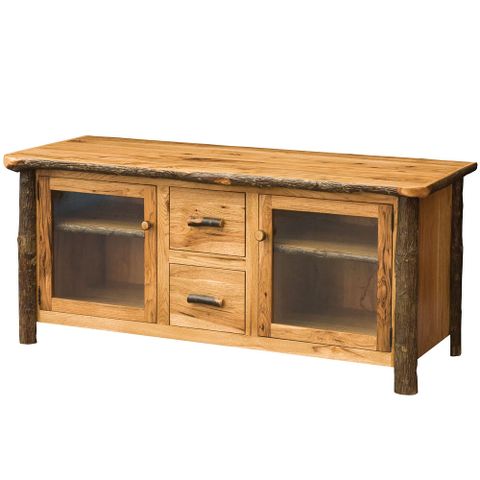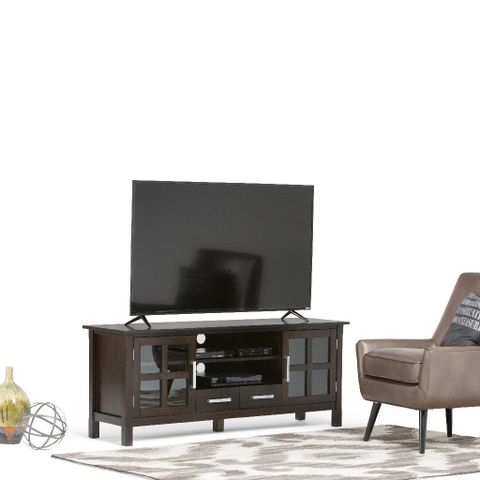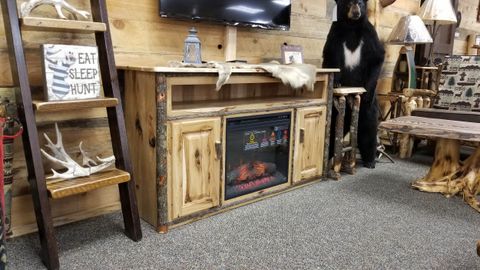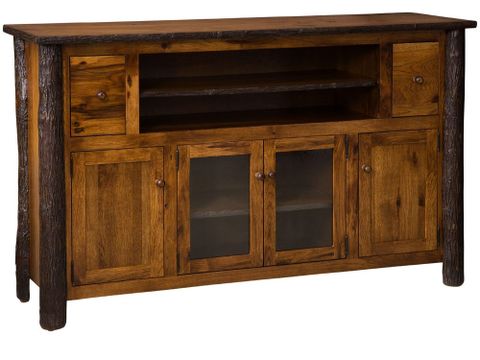Hickory. It’s a name that whispers of strength, resilience, and a touch of rustic charm. When it comes to TV stands, choosing hickory is a statement. It’s a commitment to quality, longevity, and a look that just gets better with age. But what goes into making a truly durable hickory TV stand? Let’s dive in and explore the world of this amazing wood and how to best utilize it. This isn’t just about putting some planks together; it’s about crafting a piece of furniture that will become a cherished part of your home for years to come, one that will stand up to daily use and look fantastic while doing it. And it’s also about understanding the details. You know, the stuff that separates a good stand from a great one.
Why hickory, you might ask? Well, for starters, it’s one of the hardest and most durable domestic hardwoods. This means it can take a beating, which is crucial for a TV stand that’s going to be supporting a heavy television, along with all your other entertainment gear. Think about it: remotes, gaming consoles, Blu-ray players, and the occasional spilled drink (we’ve all been there!). Hickory can handle it all. Plus, it has a beautiful grain pattern that ranges from a warm, creamy white to a rich, reddish-brown, offering a natural aesthetic that’s both elegant and inviting. And, it’s a wood that ages wonderfully, developing a richer color over time. It’s the perfect blend of practicality and beauty. We’ll go over all of the different types of hickory as well.
Choosing the Right Hickory: Grades and Types
Not all hickory is created equal. The quality of the wood you choose will heavily influence the final product. When selecting hickory, you’ll encounter different grades, typically graded by the National Hardwood Lumber Association (NHLA). Common grades you’ll find include:
- FAS (First And Seconds): The highest grade, offering the best yield of clear, defect-free lumber. This is ideal for visible parts of your stand.
- Select: Similar to FAS, but may have some minor imperfections.
- #1 Common: Contains more defects, but can be a cost-effective choice for less visible parts or where you can cut around imperfections.
- #2 Common: Contains more knots and defects. Suitable for parts that are not seen or if you are going for a rustic look.
Also, keep in mind the different types of hickory:
- Pecan Hickory: This is a bit softer than other hickories, and might not be the best choice for heavy-duty support.
- Shagbark Hickory: Known for its distinctive shaggy bark, this type is extremely hard and durable, making it a great choice for the frame of the TV stand.
- Bitternut Hickory: Generally, Bitternut is less desireable to work with due to its higher tendency to warp and twist. However, it’s still a strong wood.
Consider the specific needs of your stand and the visual aesthetic you’re aiming for when making your selection. A good lumberyard will be able to help you choose the right grade and type for your project.
Construction Techniques: The Backbone of Durability
The way you join the wood is critical to the strength and longevity of your hickory TV stand. Avoid relying solely on screws; they can loosen over time. Instead, consider these techniques:
- Mortise and Tenon Joints: These are incredibly strong joints where a tenon (a projecting piece) fits into a mortise (a hole). They’re ideal for the frame of your stand, where you need maximum stability.
- Dovetail Joints: These interlocking joints are beautiful and exceptionally strong, particularly for drawers or any place where you need to resist pulling forces.
- Dado Joints: A dado is a groove cut across the grain of a board. This is ideal for shelves that will bear weight.
- Pocket Screws: While screws alone aren’t ideal, pocket screws can be very helpful in reinforcing joints and adding extra strength, especially when used with glue.
Always use high-quality wood glue in conjunction with these joints. Glue provides a significant amount of the strength. Clamping the joints tightly while the glue dries is also important. Remember, the more solid the connections, the more durable your TV stand will be.
Design Considerations: Functionality and Aesthetics
Your hickory TV stand needs to be both beautiful and practical. Think about these design elements:
- Size and Dimensions: Measure your TV and all your other equipment, and plan the stand’s dimensions accordingly. Ensure there’s enough space for your TV, cable box, gaming consoles, and any other accessories. Consider the viewing distance from your seating area to determine the ideal height.
- Storage: Do you need open shelves, drawers, or cabinets? Plan for the storage you need, and consider the size and depth of the storage compartments.
- Cable Management: Incorporate cable management features to keep wires organized and out of sight. Drilled holes or channels in the back of the stand are essential.
- Style: Hickory works well with many design styles, from rustic and farmhouse to modern and minimalist. The grain of the wood and the finish you choose will help define the style.
- Finish: The finish you choose is vital for both protection and aesthetics. Consider:
- Oil-based finishes: These provide a warm, natural look and are relatively easy to apply.
- Water-based finishes: These are low-VOC and offer good durability.
- Varnish: Varnish provides a hard, protective coat, ideal for high-use areas.
- Stain: Stain can be used to alter the color of the wood. Always test your stain on a scrap piece of hickory first!
Tools of the Trade: Essential Equipment for the Job
Building a hickory TV stand requires the right tools. Here’s a list of essentials:
- Table Saw or Circular Saw: For cutting the wood to size accurately.
- Router: For creating joints, grooves, and decorative edges.
- Drill and Driver: For drilling holes and driving screws.
- Clamps: Essential for holding joints together while the glue dries.
- Sander: For smoothing the wood surfaces before finishing.
- Measuring Tools: Tape measure, ruler, and square for accuracy.
- Safety Gear: Safety glasses, ear protection, and a dust mask are a must.
Investing in quality tools will make the process easier and the final result more professional. A good set of chisels will also be very helpful to clean out the mortise joints. Don’t skimp on safety, either; protect your eyes, ears, and lungs.
Step-by-Step: Bringing Your Vision to Life
Here’s a simplified overview of the building process:
- Plan and Design: Create detailed plans, including dimensions, materials, and joinery methods.
- Gather Materials: Select your hickory lumber, hardware, and finish.
- Cut the Wood: Use your saw to cut all the pieces to the required size.
- Create Joints: Cut the mortise and tenon, dovetail, or other joints.
- Assemble the Frame: Glue and clamp the frame together, ensuring it’s square.
- Add Shelves and Drawers: Install shelves and assemble drawers, using appropriate joinery.
- Sand and Finish: Sand all surfaces smooth, then apply your chosen finish.
- Install Hardware: Attach handles, hinges, and any other hardware.
- Cable Management: Add cable management features.
- Enjoy! Place your TV and equipment on your new, handcrafted hickory TV stand.
Remember to take your time, measure carefully, and don’t be afraid to ask for help if you need it. There are countless online resources, from video tutorials to woodworking forums, where you can find guidance and support.
Troubleshooting Common Problems
Even experienced woodworkers encounter challenges. Here are some common issues and how to address them:
- Wood Warping: Hickory is a stable wood, but it can warp, especially if it’s not properly dried or if it’s exposed to significant changes in humidity. Store lumber in a dry, climate-controlled environment. Use proper joinery to prevent warping.
- Joints Not Fitting Properly: This is typically due to inaccurate measurements or improper cuts. Double-check your measurements, and take your time when cutting joints.
- Finish Issues: Runs, drips, and unevenness can occur when applying finish. Apply thin, even coats, and sand lightly between coats.
- Scratches and Dents: Hickory is durable, but it’s not invincible. Use felt pads under items that might scratch the surface. Repair scratches with a matching stain or finish.
- Loose Screws: If screws strip out, try using a longer screw, filling the hole with wood glue and toothpicks, or using a threaded insert.
Building a hickory TV stand is more than just a project; it’s an investment in quality and a testament to your craftsmanship. By choosing the right wood, employing sound construction techniques, and paying attention to detail, you can create a piece of furniture that will not only enhance your entertainment space but also become a cherished heirloom. The strength and beauty of hickory will stand the test of time, and with proper care, your TV stand will be a source of pride for generations to come. So, grab your tools, embrace the process, and enjoy the satisfaction of building something truly remarkable, and you’ll have something wonderful. Good luck, and happy building.




















